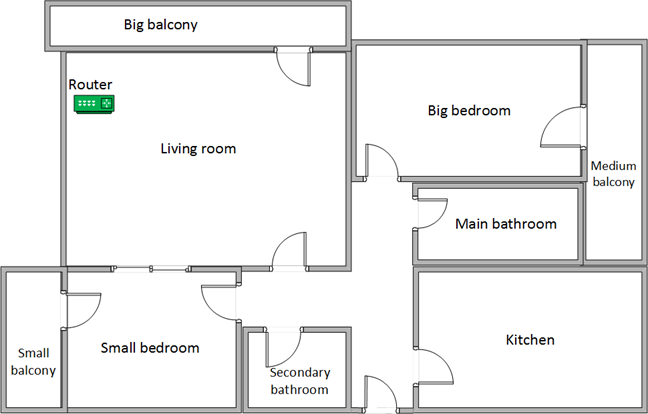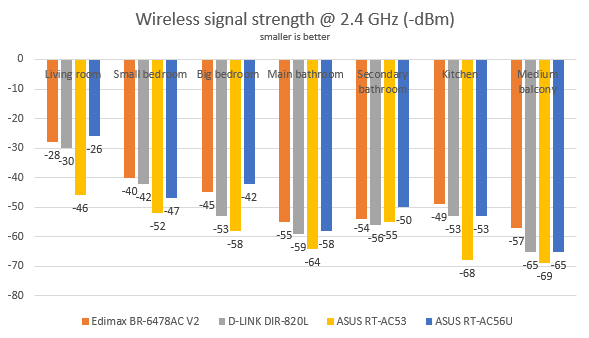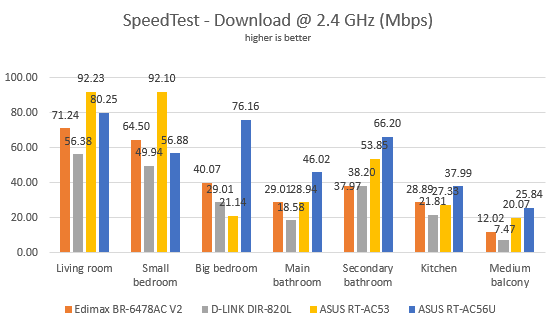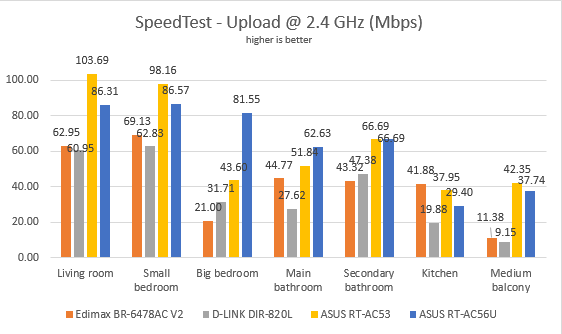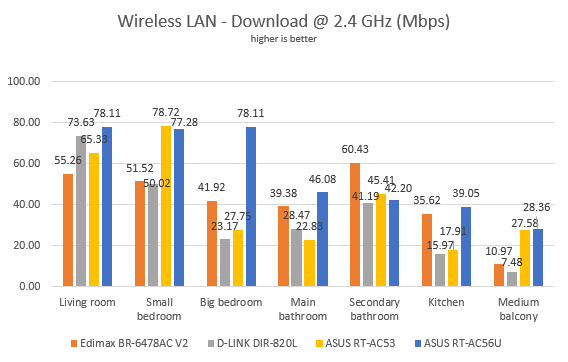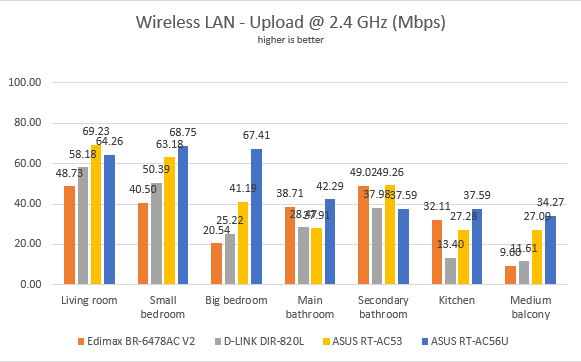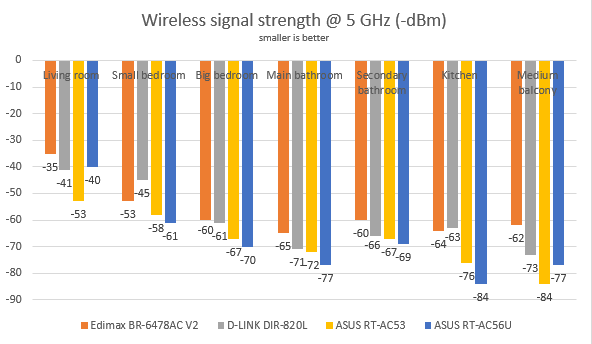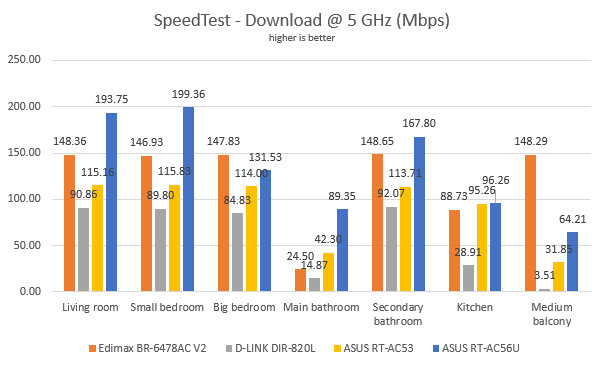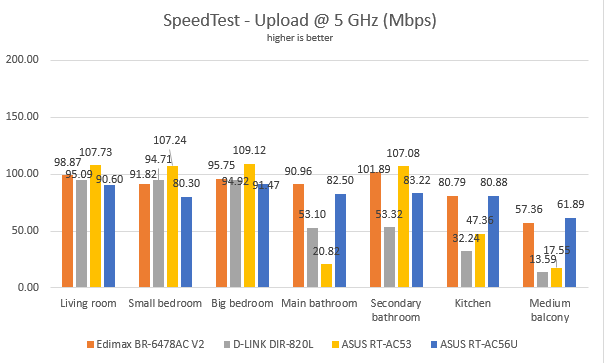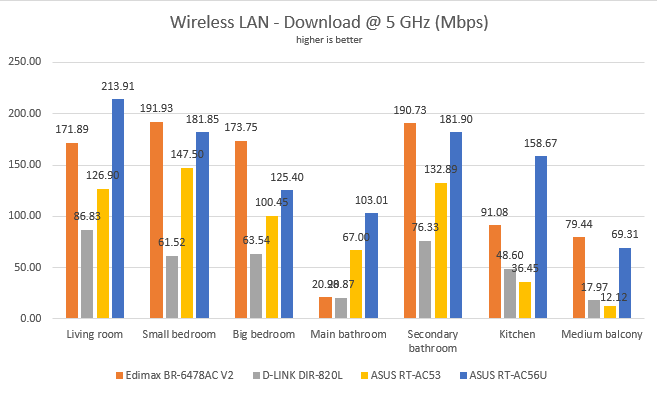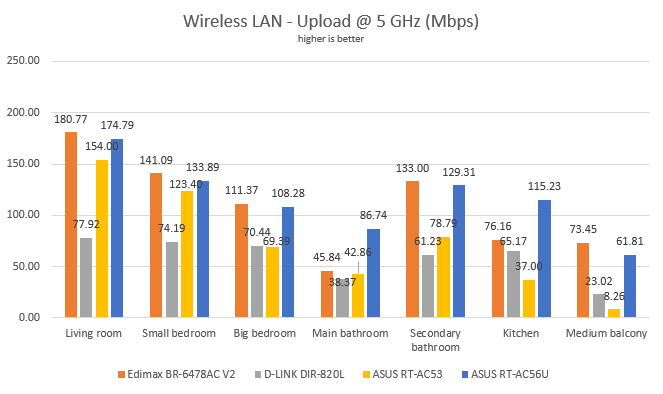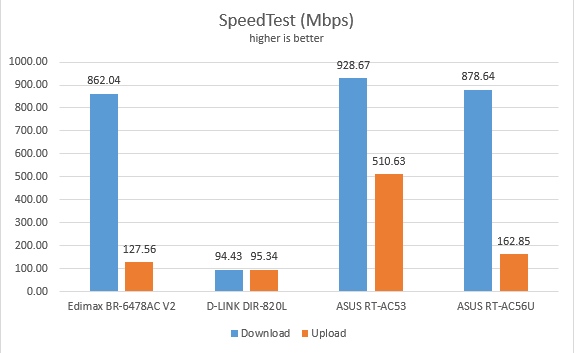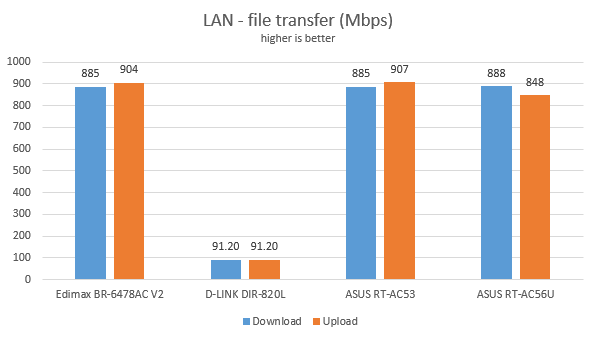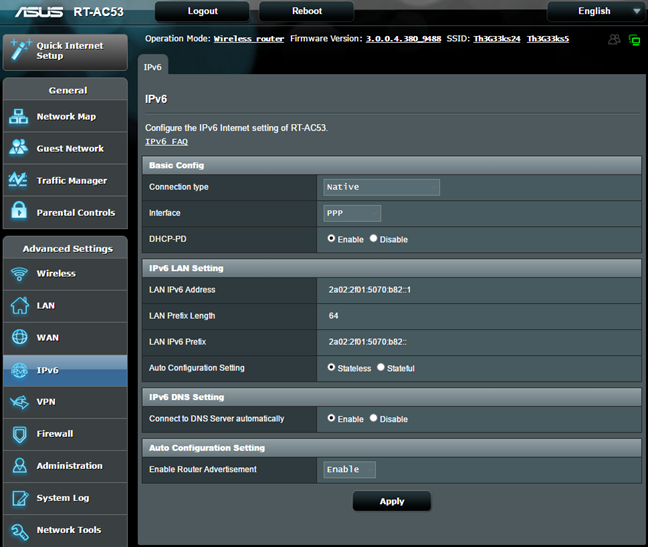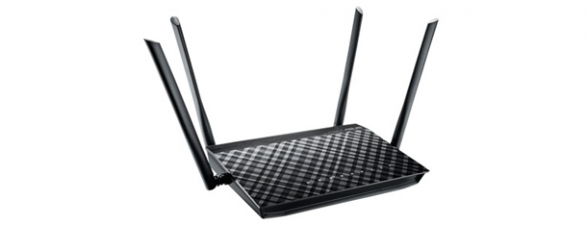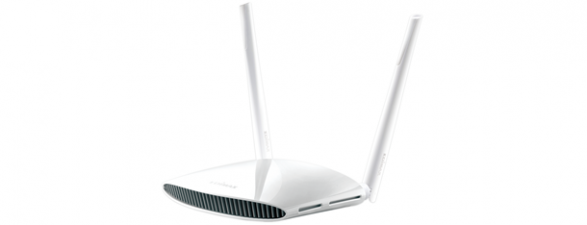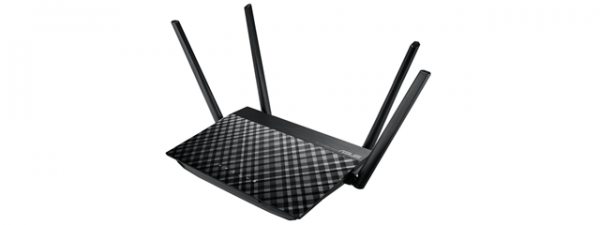
Wireless network performance
Before sharing the data from our measurements, let's take a look at the apartment that was used in our testing and how it is set up. You can see that the router is placed in the living room. With most wireless routers, the signal strength is not that great in rooms like the Kitchen and the Medium balcony.
Our testing was done using a fast 1 Gigabit Internet connection that's capable of uploads on the internet of up to 500 Mbps. We used a Microsoft Surface Pro 3 for all our measurements and several software tools. To get a better perspective of the performance offered by ASUS RT-AC53, we compared it with Edimax BR-6478AC V2, D-Link DIR-820L and ASUS RT-AC56U.
We started by evaluating the 2.4 GHz wireless network and measured the signal strength offered in each room, using a tool named inSSIDer. As you can see in the graph below, the signal strength offered by ASUS RT-AC53 is not spectacular by any means.
Then, we used SpeedTest to measure how fast the Internet connection offered by this router is. In the download test, ASUS RT-AC53 was fast in the two rooms closest to it and rather slow in all others. What is not evident from this table is that in the Medium Balcony, we encountered frequent disconnects and sometimes, the wireless network did not work at all. However, when it did work, we measured an average speed of 20.07 Mbps, which is okay for that room, proving that this router has the potential to offer satisfactory speed.
In the upload test, the performance improved across the board.
Continuing our measurements on the 2.4 GHz wireless network, we used LAN Speed Test Lite to measure downloads and uploads when transferring a 350MB file between two computers connected to the network. When measuring the download speed, ASUS RT-AC53 performed well only in the two rooms closest to it: the Living Room and the Small bedroom.
Again, in the upload test, ASUS RT-AC53 performed better than in the download test.
The 2.4 GHz wireless network offered by ASUS RT-AC53 suffers from variability and performance drops. The hardware inside this router is able to offer stable wireless connections but its firmware has some bugs which negatively affect your experience. We hope that they will be fixed in future firmware updates.
Next, we analyzed the performance offered by the 5GHz wireless network. First, we looked at the evolution of the signal strength, from room to room. The signal strength offered by ASUS RT-AC53 is below what was offered by most of the routers we compared it to.
We moved to SpeedTest, to measure the speed of the Internet connection on the 5GHz wireless network. The download speed was good in the rooms closest to the router but it dropped significantly in the other rooms.
ASUS RT-AC53 performed better when measuring the upload speed on the internet, managing to be the fastest router in several rooms.
Lastly, we used LAN Speed Test Lite to measure downloads and uploads when transferring a 350MB file between two computers connected to the network. Again, the download speed was good in the rooms closest to the router but it dropped significantly in the other rooms.
Its performance was similar when measuring the upload speed.
When we tested the 5GHz wireless network, we encountered temporary disconnects. In the Medium Balcony, where the signal strength is the weakest, they were very frequent and we couldn't productively use the network.
The 5 GHz wireless network offered by ASUS RT-AC53 is suffering from variability and performance drops. The firmware has some bugs which negatively impact your experience. We hope that they will be fixed in future firmware updates.
Wired network performance
In order to test the quality of the wired Ethernet connection, we used a desktop PC, equipped with an Intel Core i5 4460 processor, running at 3.20GHz, 16GB of RAM and a very fast Samsung 850 Pro 512GB SSD and a Microsoft Surface Pro 3 with an Intel Core i5-4300U processor, running at 1.9 GHz, 8 GB of RAM and a fast 256 GB SSD drive from Samsung.
We started by measuring the download and upload speeds using SpeedTest. As you can see below, ASUS RT-AC53 managed to offer downloads which are very close to 1 Gbps. Also, it achieved the maximum upload speed possible on our internet connection. The routers we compared it to delivered less than 200 Mbps because, when testing them, our internet connection was capped at 200 Mbps for the upload speed. Now it is capped at 500 Mbps.
For the last measurement, we transferred an 883 MB file between the same two computers connected to the network, both of which were using an Ethernet cable. Again, ASUS RT-AC53 was a very good performer, with transfers close to 900 Mbps.
ASUS RT-AC53 delivers real 1 Gbps Ethernet connections, as promised in its specifications. It is a shame that it has only two Ethernet ports.
Extra features
ASUS RT-AC53 offers the following extra features:
- Guest Network - you can set up to six guest wireless networks that provide internet access but restrict access to your network. You can enable up to three 2.4GHz guest networks and up to three 5GHz guest networks.
- Traffic Manager Quality of Service (QoS) - a basic QoS service that you can use to set speed limits for individual devices on your network.
- Parental Controls - A basic parental controls module that you can use to set a schedule for the devices that are used by your children. You cannot use it to filter adult content or any other type of content that is inappropriate for children.
- VPN Server - you can set the router to work as a VPN server and you can also use it to turn your network-connected devices into VPN-enabled clients via the OpenVPN and PPTP protocols, without additional VPN software.
- Network Tools - for analyzing the network and identifying what's wrong. They are useful when you need to troubleshoot problems.
- ASUS Router - a mobile app for iOS and Android, which allows you to monitor and manage your wireless router from your smartphone.
- DDNS - a service that allows you to connect to the router from the internet, even if your internet provider gives you a dynamic public IP address.
- IPv6 - support for internet connections using the Internet Protocol version 6.
ASUS RT-AC53 offers a few extra tools, which is great for a router in its price-range. Some of them are useful, like the possibility of turning it into a VPN server.
Pros and cons
ASUS RT-AC53 has the following good things going for it:
- It's priced very affordably
- The firmware is very configurable and easy to use
- It has some useful extra features, including the possibility to make it run as a VPN server
- It has good multi-lingual support
- The Help documentation is well made and easily accessible
- It can be mounted on walls
The are also some important downsides to consider:
- There's no USB port available for connecting external devices to the router
- The wireless network broadcast by ASUS RT-AC53 has stability issues
- The signal strength is not great and it is suitable just for small-sized apartments
Verdict
ASUS RT-AC53 is a basic wireless router, with a very affordable price. It doesn't promise you the world and it doesn't deliver it either. From a hardware perspective, this router is promising and it could be a best buy in its price-range. However, its firmware issues hold it down. ASUS needs to improve the bugs in this device's firmware, so that it can deliver a more stable wireless signal. Until they deliver such fixes, ASUS RT-AC53 is a good choice only for small apartments and for networks which don't include many wireless devices.




